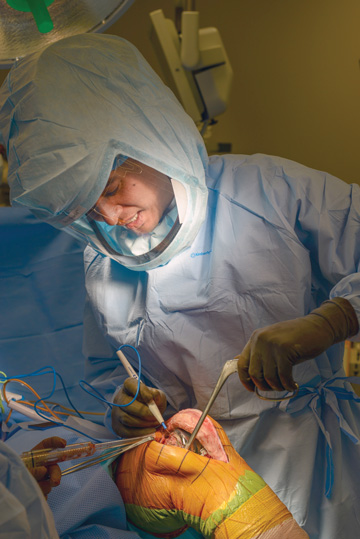Dr. Limoni likens cryo to placing an ice cube next to the nerve, which stuns and freezes it, and generally provides pain relief for about three months. He believes the treatment, which he calls a “game-changer,” has directly led
to many patients rehabbing more quickly and with fewer opioids. “Our whole pursuit is the narcotic-free total knee,” he says. “I do think that is attainable, and cryo is a big player in that.”
While there are potential risks — such as bruising, frostbite and swelling around the treated area that could lead to permanent nerve damage, infection or hematomas — Dr. Limoni says these are largely due to provider inexperience
and can usually be avoided with the precision of ultrasound guidance. “Ultrasound enables more directed treatments that are less invasive to the soft tissues by allowing you to visualize the branch of the nerves and place the cold
probe directly at the nerve in just a couple spots, as opposed to just picking a location in the leg where the nerves are and doing a pattern that covers a broad area,” he says.
Dr. Limoni’s advanced practitioners usually apply the cryo treatment, which takes around a half-hour, to patients about a week before surgery. “Patients simply walk out afterward, and probably three-fourths of them have near-immediate
pain relief,” he says.
This long-lasting treatment is also helpful for patients who require significant preoperative optimization and interim relief. “When someone isn’t optimized for surgery — they need to lose weight, stop smoking or have another
procedure done prior — we’ll use cryo to buy time,” says Dr. Limoni.
Cryo treatments work well in conjunction with perioperative regional blocks of much shorter duration to keep pain at bay for weeks postoperatively. “Blocks provide relief for the first 24 or maybe 48 hours, but then you’re relying
on narcotics to get patients through the first two weeks of recovery,” says Dr. Limoni.
Cryo positively impacts the rehab process, too, according to Dr. Limoni. “That first two months is essential to getting range of motion back, and patients who really struggle with this have unacceptable pain levels,” he says. “They
don’t want to move their knee and end up having long-term consequences. By adding cryo to their treatment plan, we see a lot less patients having issues with stiffness, needing closed manipulations or having suboptimal outcomes.”
The treatments also allows patients to avoid narcotic side effects such as dizziness and urinary issues that can cause falls and delay rehab and healing. It also reduces the likelihood of blood clots.
Despite all the benefits, there are reimbursement challenges associated with cryo treatments due to its limited usage in a clinical setting. “Insurance approval has been a challenge,” says Dr. Limoni. “One issue is that it’s
difficult to get large amounts of data and prospective studies on it, and payers want large amounts of data to prove value.” Still, Dr. Limoni and his facility leader believe in the treatment and are committed to using it for their
patients when it’s appropriate to do so.
.svg?sfvrsn=be606e78_3)

.svg?sfvrsn=56b2f850_5)